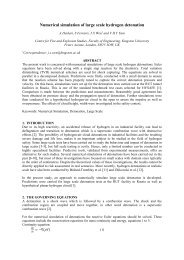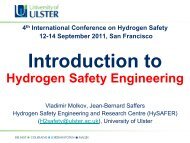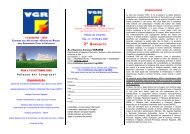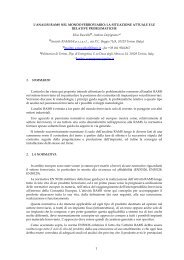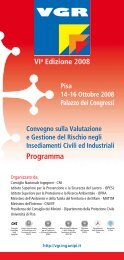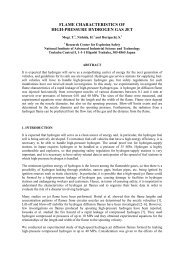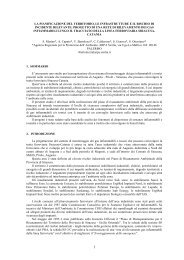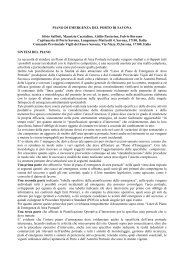relational information system for chemical accidents database (riscad)
relational information system for chemical accidents database (riscad)
relational information system for chemical accidents database (riscad)
Create successful ePaper yourself
Turn your PDF publications into a flip-book with our unique Google optimized e-Paper software.
RELATIONAL INFORMATION SYSTEM FOR<br />
CHEMICAL ACCIDENTS DATABASE (RISCAD)<br />
WITH ANALYSIS OF HYDROGEN ACCIDENT<br />
Wada, Y. 1 , Katoh, K. 1 , Abe, S. 1 , Owa Heisig, K. 1 and Ogata, Y. 1<br />
1 Research Core <strong>for</strong> Explosion Safety (ESCORE),<br />
National Institute of Advanced Industrial Science and Technology (AIST),<br />
AIST West Site, 16-1 Onogawa, Tsukuba, 305-8569, Japan, yuji.wada@aist.go.jp<br />
ABSTRACT<br />
The Relational In<strong>for</strong>mation System <strong>for</strong> Chemical Accidents Database (RISCAD) is based on the fire,<br />
explosion, and leakage accident data related to <strong>chemical</strong> substance, <strong>chemical</strong> process, high pressure<br />
gas, and explosive. These data have been accumulated by the National Institute of Advanced Industrial<br />
Science and Technology (AIST). RISCAD has been developed by AIST and the Japan Science and<br />
Technology Agency (JST) from 1999 and released on the WWW in October 2002. In RISCAD,<br />
accident data can be searched by date, location and free words or keywords by activities, equipment,<br />
causes, <strong>chemical</strong>, and substance names which were hierarchized by the experts. Some accident data<br />
are linked <strong>relational</strong>ly to the accident progress flowcharts, hazard <strong>in<strong>for</strong>mation</strong> of relevant <strong>chemical</strong>s<br />
and additional <strong>in<strong>for</strong>mation</strong> such as the reaction process flowcharts, reaction <strong>for</strong>mula, equipment and<br />
facility layout. Additionally, it has the functions to reproduce dynamically thermal analysis (DSC)<br />
data and accident statistic data on the Web browser. In this paper, the outline and the functions of<br />
RISCAD are introduced. Also, a case study is presented, that is related on hydrogen, with the progress<br />
flowchart.<br />
1.0 INTRODUCTION<br />
"Relational In<strong>for</strong>mation System <strong>for</strong> Chemical Accidents Database” (RISCAD; http://www.aist.go.jp/<br />
RIODB/RISCAD/), which was developed jointly by the National Institute of Advanced Industrial<br />
Science and Technology (AIST) and the Japan Science and Technology Agency (JST), was released<br />
on the Web in October, 2002. This paper introduces the outline of RISCAD and a case study on the<br />
accident in Japan related on hydrogen in 2005 together with the progress flowcharts.<br />
2.0 CONCEPT OF RISCAD<br />
In the "Material Safety (MS) Seminar", which Professor Terushige Ogawa (Yokohama National<br />
University) established, an expert <strong>system</strong> <strong>for</strong> the safety assessment of <strong>chemical</strong> plants is being<br />
developed. In this <strong>system</strong>, the necessity of analysis of past <strong>accidents</strong> became clear [1-6]. However,<br />
regarding the Japanese conventional accident <strong>database</strong>, it consisted mainly of text <strong>in<strong>for</strong>mation</strong>, with<br />
only the summary of <strong>accidents</strong> being recorded, and was lacking in providing were knowledge or<br />
lessons. There<strong>for</strong>e it was decided to develop an accident <strong>database</strong> which would serve as a link between<br />
<strong>accidents</strong> and relevant hazard substances, as well as providing <strong>in<strong>for</strong>mation</strong> to help in the<br />
understanding of <strong>accidents</strong>.<br />
The <strong>database</strong> project was started with financial assistance from "The Database Development Program"<br />
of JST <strong>for</strong> three years from October, 1999, and with support from "The Technical Advisory<br />
Committee" comprising members of the "MS seminar". RISCAD was released in October, 2002.<br />
How to offer useful <strong>in<strong>for</strong>mation</strong> to prevent the recurrence of similar <strong>accidents</strong> by users of a <strong>chemical</strong><br />
substance was considered during development. There<strong>for</strong>e hazard <strong>in<strong>for</strong>mation</strong> relevant to substances<br />
related to <strong>accidents</strong>, classification of <strong>accidents</strong> by hierarchized keywords, and additional <strong>in<strong>for</strong>mation</strong>,<br />
such as progress flowcharts, structural <strong>for</strong>mula, figures, etc., were collected. With these, a user of<br />
<strong>chemical</strong> substances can search <strong>for</strong> accident related <strong>in<strong>for</strong>mation</strong>, depending on the substance and<br />
operating conditions.
The aim of RISCAD was to fully understand the hazards related to <strong>chemical</strong> substances and the<br />
situation in which an accident had occurred. Thermal hazard data in particular was recorded regarding<br />
<strong>chemical</strong> substances. In addition, thermal analysis (Deferential Scanning Calorimetry: DSC) data was<br />
collected and the function equipped so that a user could analyze DSC data on the Web browser<br />
dynamically.<br />
Experts constructed a <strong>system</strong> whereby <strong>accidents</strong> are classified by hierarchized keywords : final events,<br />
activities, equipment, probable causes and damage. And a search function using hierarchized<br />
keywords <strong>for</strong> the each category was installed.<br />
Additional image <strong>in<strong>for</strong>mation</strong>, except <strong>for</strong> text <strong>in<strong>for</strong>mation</strong>, such as <strong>chemical</strong> reaction process flow,<br />
devices and facilities layout, schematic diagrams of the device at which an accident occurred, and<br />
reaction <strong>for</strong>mula etc., was recorded.<br />
It was also equipped with a display chart showing accident search results, and was also equipped with<br />
function which could change the parameters of the chart on the Web browser dynamically.<br />
Concerning the analysis of each accident, an accident progress flowchart which extracted a lag from<br />
the normal state that triggered an accident was made by experts.<br />
3.0 OUTLINE OF RISCAD<br />
3.1 Recorded Accidents<br />
The duration of <strong>accidents</strong> collected is from October 28, 1949 to December 12, 2004, and the number<br />
was over 4,350 as of the end of April, 2007<br />
The sources of accident records are those of "The Hazard and Accident Database"<br />
(http://www.aist.go.jp/RIODB/cgi-pub019/DB019_top_jpn.cgi), which is one of "The Research<br />
In<strong>for</strong>mation Databases (RIO-DB)" of AIST (about 4,000 records), a book of "Reaction Hazard -<br />
Accident and Analysis - " [7], accident reports of hazardous substances related with The Japanese<br />
"Fire Service Law" and The Japanese "Industrial Safety and Health Law", news reports of recent<br />
<strong>accidents</strong>, and originally collected <strong>accidents</strong> by the "MS seminar".<br />
"The Hazard and Accident Database" records many <strong>accidents</strong> related to high pressure gas and<br />
explosives, and RISCAD was designed in consideration of these <strong>accidents</strong>.<br />
The thermal hazard data relevant to accident related substances was based on <strong>in<strong>for</strong>mation</strong> from<br />
"Bretherick's Handbook of Reactive Chemical Hazard" [8] and the "Handbook of Mixture Hazard of<br />
Chemical Substances" [9]. The thermal analysis (DSC) data were provided by Yokohama National<br />
University, The University of Tokyo, and AIST.<br />
3.2 Characteristics<br />
RISCAD has a search by date function, location, and an accident summary (full text search by free<br />
words) like that of general accident <strong>database</strong>s.<br />
In addition, RISCARD has the following characteristics.<br />
(1) A search function by keywords hierarchized by experts, such as final events, activities, equipment,<br />
probable causes and damage.<br />
For example hierarchized keywords concerning probable causes are shown in Tables 1. The following<br />
discussions were carried out concerning keywords about probable causes. "Human Factor" and<br />
"Organization Factor" were established as the 1st categories in order to separate the simple mistakes of<br />
operators and root causes related to organizations. "Substance Factor/Reaction Factor", which were
important as causes of <strong>chemical</strong> <strong>accidents</strong> were established as the 1st category. And in that category,<br />
"Formation of Inflammable Gaseous Mixture" and "Contact with Impurity" were established as sub<br />
categories, because they became causes in many <strong>accidents</strong>. "Impurity" in that keyword was defined as<br />
including the air and the moisture which there must not be in the <strong>system</strong>. To prevent similar <strong>chemical</strong><br />
<strong>accidents</strong>, classification by trigger events was important, there<strong>for</strong>e "Stimulus Factor" was established<br />
as the 1st category.<br />
Table 1. Hierarchized keywords about probable causes.<br />
(2) Search function by other names (synonyms) of <strong>chemical</strong> substances.<br />
The "Japanese Chemical Substances Dictionary" (JCHEM), which JST developed was used in<br />
RISCAD. The following are examples of synonyms by JCHEM. Synonyms of "Ethanol"; ethyl<br />
alcohol, alcohol, ethane-1-ol, methyl carbinol, ethyl hydrate, spirit, and wine spirit.<br />
(3) Dynamic statistical analysis on the Web browser.<br />
RISCAD has the function to show the search results of <strong>accidents</strong> dynamically on the Web browser. A<br />
choice is possible from a pile bar chart, a side bar chart, a line chart, a pie chart, and a distribution map<br />
of Japan. A RISCAD chart choice screen is shown in Figure 1.
Figure 1. Chart types to show statistical analysis on RISCAD.<br />
(4) Link to thermal hazard data relevant to <strong>chemical</strong> substance <strong>accidents</strong>.<br />
The thermal hazard data screen shows the following <strong>in<strong>for</strong>mation</strong> : Substance ID, CAS number,<br />
JCHEM number, substance name, other names (synonyms), <strong>chemical</strong> <strong>for</strong>mula, rational <strong>for</strong>mula,<br />
boiling point (˚C), flash point (˚C), condition of flash point, ignition point (˚C), condition of ignition<br />
point, lower explosion limit (%), upper explosion limit (%), mixture hazard, classification of thermal<br />
hazard, and United Nations hazard classification. The classification of thermal hazard was developed<br />
by the "MS seminar".<br />
(5) Dynamic analysis of thermal analysis (DSC) data on the Web browser.<br />
(6) Link to images of additional <strong>in<strong>for</strong>mation</strong>.<br />
The images of additional <strong>in<strong>for</strong>mation</strong> are those such as the <strong>chemical</strong> reaction process flow, the devices<br />
and facilities layout, the schematic diagram of the device at which an accident was occurred, reaction<br />
<strong>for</strong>mula, etc. Examples of additional <strong>in<strong>for</strong>mation</strong> are shown in Figure 2.<br />
(7) Link to the accident progress flowchart.<br />
The accident progress flowchart was analyzed by time series, and the trigger events or causes were<br />
extracted so as to be able to fully understand the accident. Finally, we extracted and learn lessons from<br />
the accident progress flowchart.
Figure 2 Examples of additional <strong>in<strong>for</strong>mation</strong>.<br />
(8) Search function of hazard <strong>in<strong>for</strong>mation</strong> by substance name.<br />
At first, RISCAD could show hazard <strong>in<strong>for</strong>mation</strong> only <strong>for</strong> substances relevant to the searched<br />
<strong>accidents</strong>. So, a function to search <strong>for</strong> and show hazard <strong>in<strong>for</strong>mation</strong> by substance names was added in<br />
compliance with <strong>database</strong> users. By this function, a hazard <strong>in<strong>for</strong>mation</strong> <strong>database</strong>, mainly mixture<br />
hazard, comprising more than 4.000 substances recorded in RISCAD, became available to <strong>database</strong><br />
users.
4.0 CASE STUDY<br />
Case studies were carried out on an accident related hydrogen by making progress flowchart. At first,<br />
one of our investigation team investigated an accident report alone and made a draft progress<br />
flowchart. Then, all investigation team members discussed about the accident, <strong>for</strong> example, the root<br />
causes that were not written in the accident report, and updated the progress flowchart.<br />
Explosion at the High-compressed Hydrogen Energy Generator (HHEG)<br />
Date : December 7, 2005, Time : 13:22, Place : Fukuoka, Japan,<br />
Final Event : Explosion, Damage : Human - No Injury, Physical - Accident Institution, Five Cars,<br />
Probable Cause : Reaction of Titanium Electrode and/or Combustion of Hydrogen/Oxygen Mixture,<br />
Involved Substances : Hydrogen, Oxygen, Titanium, Fluorine, etc.,<br />
Outline of the accident :<br />
An explosion occurred during the operation of the High-compressed Hydrogen Energy Generator<br />
(HHEG) in the verification test facilities of the hydrogen station within an university campus. The<br />
electrolysis cell in the HHEG burned down, pipes bursted and the peripheral equipments scattered all<br />
over the facilities. The liquid blown out from the bursted pipes and the gas release valve, and glass<br />
fragments were scattered within 10 meter radius. The water splash caused microscopic corrosion on<br />
the windows and hoods of five cars. There was no injuries. The titanium electrode in the electrolysis<br />
cell of the HHEG and/or hydrogen were burned, then water containing hydrogen flowed to the oxygen<br />
pipe. At that time, the metal fragments flowed in the oxygen pipe then it caused an explosion and the<br />
pipe bursted.<br />
The Progress flowchart of this accident is shown in Figure 3.<br />
Lessons Learned :<br />
Risk assessment on test operation : Risk assessment should be done to know the risk of the operation<br />
and to take safety measures even if the operation is under testing or temporary.<br />
High pressure oxygen can burn metals : Under high pressure oxygen, even metals could burn. If<br />
equipment is contacted with oxygen, it should be made of material that is well examined under<br />
ordinary operating condition.<br />
Pressure rises at the closed end of pipe : If pressure wave happens in a pipe, it may cause excessive<br />
pressure than the strength of the pipe at the closed end of pipe and it will burst.<br />
Safety management <strong>system</strong> at institutes : Institutes, including university, should organize the safety<br />
management <strong>system</strong>, even if they do only test or temporary operations.
5.0 CONCLUSION<br />
Figure 3. Progress flowchart of the accident at the HHEG.<br />
A <strong>chemical</strong> <strong>accidents</strong> <strong>database</strong> with many useful functions <strong>for</strong> <strong>database</strong> users who want to prevent the<br />
recurrence of a similar accident as those in the past and who want to know the hazards of <strong>chemical</strong><br />
substances which they plan to use, was released as RISCAD on the Web. One of the characteristics of<br />
RISCAD is its link to the accident progress flowchart analyzed by experts. To make a progress<br />
flowchart and discuss an accident with it, it is very useful <strong>for</strong> understanding an accident and drawing<br />
lessons from it. And to learn about an accident by RISCAD with the progress flowchart will also be<br />
helpful to <strong>database</strong> users in understanding an accident and clarifying how to prevent it happening.
By a case study of an accident related on hydrogen, it proved a necessity and importance of risk<br />
assessment on every operation even if it is a test operation or a temporary operation.<br />
Anyone can use RISCAD free of charge via Internet. RISCAD will be improved in compliance with<br />
<strong>database</strong> users’ requests.<br />
ACKNOWLEDGMENT<br />
RISCAD was developed by financial assistance from "The Database Development Program" of Japan<br />
Science and Technology Agency (JST). "The Technical Advisory Committee" (Chair : Professor<br />
Terushige Ogawa, Yokohama National University) supported from making concepts of RISCAD in<br />
collecting and recording <strong>accidents</strong>. "The Working Group on Safety In<strong>for</strong>mation / The environment and<br />
Safety Committee" of "The Japan Explosives Society" supported the making a <strong>for</strong>m of progress<br />
flowchart. The Research Database Office, Technology In<strong>for</strong>mation Department, AIST and Tsukuba<br />
Advanced Computing Center, AIST supported the release of RISCAD, and they are also supporting its<br />
maintenance. The authors gratefully acknowledge the support from all of them.<br />
REFERENCES<br />
1. Nobe, J., Oka, Y., Takasaki, R., Shimizu, Y., Wakakura, M., and Uchida, T., Development of<br />
safety deduction engine <strong>for</strong> the <strong>chemical</strong> process, Proceedings of the 29th Symposium on Safety<br />
Engineering, Tokyo, Science Council of Japan, 1999, pp.251-254 (in Japanese).<br />
2. Takasaki, R., Oka, Y., Miyake, A., Ogawa, T., Uchida, T., Shimizu, Y., Nobe, J., and Wakakura,<br />
M., Hazard cause deduction <strong>system</strong> based on analyzing <strong>accidents</strong> in <strong>chemical</strong> process,<br />
Proceedings of the 32nd Annual Conference of the Japan Society <strong>for</strong> Safety Engineering,<br />
Kitakyushu, Japan Society <strong>for</strong> Safety Engineering, 1999, pp.173-176 (in Japanese).<br />
3. Takasaki, R., Oka, Y., Miyake, A., Ogawa, T., Wakakura, M., Nobe, J., and Wada, Y.,<br />
Development of safety assessment <strong>system</strong> <strong>for</strong> <strong>chemical</strong> process, Proceedings of the 33rd Annual<br />
Conference of the Japan Society <strong>for</strong> Safety Engineering, Yokohama, Japan Society <strong>for</strong> Safety<br />
Engineering, 2000, pp.121-124 (in Japanese).<br />
4. Takasaki, R., Nobe, J., Wada, Y., Wakakura, M., and Miyake, A., Hazard identification <strong>system</strong><br />
based on fire and explosion <strong>accidents</strong> in <strong>chemical</strong> processes, Proceedings of Asia Pacific<br />
Symposium on Safety, Vol.1, Kyoto, Japan Society <strong>for</strong> Safety Engineering, 2001, pp.151-154.<br />
5. Takasaki, R., Nobe, J., Wada, Y., Oka, Y., Miyake, A., Wakakura, M., and Ogawa, T.,<br />
Development of safety assessment <strong>system</strong> based on analyzing accident in <strong>chemical</strong> process,<br />
Proceedings of the 35th Annual Conference of the Japan Society <strong>for</strong> Safety Engineering,<br />
Yokohama, Japan Society <strong>for</strong> Safety Engineering, 2002, pp.137-140 (in Japanese).<br />
6. Takasaki, R., Oka, Y., Miyake, A., Ogawa, T., Wakakura, M., Nobe, J., and Wada, Y., A study on<br />
pattern recognition in development of hazard deduction <strong>system</strong> <strong>for</strong> <strong>chemical</strong> process, Proceedings<br />
of the 33rd Symposium on Safety Engineering, Tokyo, Tokyo: Science Council of Japan, 2003,<br />
pp.334-337 (in Japanese).<br />
7. Tamura, M., and Wakakura, M., Reaction Hazard - Accident and Analysis, 1995, Shisaku Kenkyu<br />
Center, Tokyo (in Japanese).<br />
8. Bretherick, L., Urben, P.G., Pitt, M.J., and Batte, L.A., Bretherick’s Handbook of Reactive<br />
Chemical Hazards (5th Ed.), 1995, Butterworth-Heinemann, Ox<strong>for</strong>d.<br />
9. Yoshida, T., and Tamura, M., Edited by Tokyo Fire Department, Handbook of Mixture Hazard of<br />
Chemical Substances, 1997, The Nikkan Kogyo shimbun, Tokyo (in Japanese).



